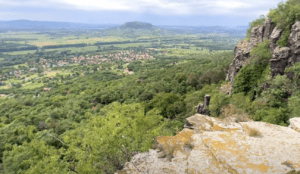The volcanic field of the Bakony-Balaton highlands received prestigious recognition

The area of the Bakony-Balaton highlands contains one of the densest volcanic fields in Europe. During the Late Miocene to Pleistocene period, between about 8 and 2.5 million years ago, about 50 volcanoes were active in this area. Magma at more than 1,000 degrees Celsius broke through cracks in the earth’s crust to continue its journey as lava when it reached the surface.
The special feature of the volcanic activity lies in the fact that the magma met the water stored in the medieval carbonate rocks and the sediments of the former Lake Pannon. This encounter produced violent steam explosions known as phreatomagmatic explosive volcanism. Typical tuff rings and maar-diatreme structures formed around such volcanoes, which were shaped by erosion over millions of years into their present form.
The volcanoes of the Tapolcai Basin are particularly noteworthy, as these volcanoes were active between 4.5 and 3 million years ago and have survived in the form of today’s witness mountains. These volcanic hills are special because the level of their tops is aligned with the surface that existed at the time of the volcanic eruptions and has been eroded since then.
Related news
The 2024 tourism record was achieved in 11 months this year
🎧 Hallgasd a cikket: Lejátszás Szünet Folytatás Leállítás Nyelv: Auto…
Read more >A new era in Budapest’s tourism management: the capital’s TDM model is transforming
🎧 Hallgasd a cikket: Lejátszás Szünet Folytatás Leállítás Nyelv: Auto…
Read more >Five critical mistakes that Hungarian companies still make when it comes to business travel
🎧 Hallgasd a cikket: Lejátszás Szünet Folytatás Leállítás Nyelv: Auto…
Read more >Related news
Record-breaking Black Friday in online orders
🎧 Hallgasd a cikket: Lejátszás Szünet Folytatás Leállítás Nyelv: Auto…
Read more >Campaign launched to dispel misconceptions about meat and dairy products
🎧 Hallgasd a cikket: Lejátszás Szünet Folytatás Leállítás Nyelv: Auto…
Read more >The newest PENNY store opened in downtown Szolnok
🎧 Hallgasd a cikket: Lejátszás Szünet Folytatás Leállítás Nyelv: Auto…
Read more >







